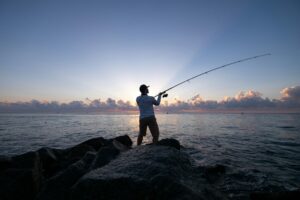Casting Beyond the Shore A Complete Guide to the World of Fishing


Fishing is one of humanity’s oldest survival skills, yet it has evolved into a beloved recreational and commercial activity worldwide. From ancient riverbanks to modern deep-sea adventures, fishing connects people with nature, food, and tradition. Today, it is celebrated as both a sport and a sustainable practice that continues to play a vital role in cultures and economies.
The Historical Roots of Fishing
Archaeological evidence indicates that fishing has been practiced for over 40,000 years. Early humans used spears, hooks carved from bone, and simple nets to catch food from rivers and seas. Fishing was essential for survival in coastal communities and laid the foundation for trade in many ancient civilizations. Over time, tools and techniques improved, transforming fishing from a necessity into an art and science.
Different Types of Fishing Practices
Fishing takes many forms depending on location, technique, and purpose. Recreational anglers may enjoy freshwater fishing in lakes or fly fishing in mountain streams. Saltwater enthusiasts head to oceans for deep-sea or shore fishing. Commercial fishing, on the other hand, supplies millions of people worldwide with seafood, using advanced technology and large-scale vessels. Each method has its own challenges, rewards, and traditions.
Popular Freshwater Fishing Styles
Freshwater fishing is often the starting point for beginners. It includes casting lines in lakes, rivers, and ponds, targeting species such as bass, trout, and catfish. Fly fishing is another popular technique, requiring specialized rods and artificial flies that mimic insects. Freshwater fishing is accessible, affordable, and ideal for families, making it one of the most practiced forms of fishing worldwide.
Adventures in Saltwater Fishing
Saltwater fishing offers an entirely different experience. Whether casting from a beach, pier, or boat, anglers can catch species like tuna, marlin, and snapper. Deep-sea fishing is especially thrilling, as it involves venturing miles offshore into vast waters. Saltwater environments demand stronger equipment and greater skill, but they also reward anglers with some of the most exciting catches in the fishing world.
Sport Fishing and Competitive Angling
Fishing has also grown into a competitive sport. Anglers participate in tournaments where they compete to catch the largest or most fish within a set time. These events not only test skills but also promote conservation by encouraging catch-and-release practices. Sport fishing combines the thrill of competition with the relaxation of time spent outdoors, making it a dynamic and engaging pursuit.
The Role of Fishing in Global Economies
Fishing is more than a hobby—it is a lifeline for many economies. Commercial fishing supplies seafood to billions of people, supporting jobs in harvesting, processing, and distribution. Countries such as Japan, Norway, and the United States heavily depend on their fishing industries. However, sustainable practices are crucial to ensure fish populations remain healthy for future generations.
Environmental Challenges in Fishing
While fishing brings enjoyment and sustenance, it also presents environmental challenges. Overfishing has depleted particular species, disrupting ecosystems and threatening biodiversity. Bycatch, or the accidental capture of non-target species, adds to these concerns. Climate change also affects fish populations by altering ocean temperatures and habitats. Addressing these issues is crucial for maintaining a balance between fishing and the natural world.
Sustainable Fishing Practices
To protect marine life and ecosystems, sustainable fishing practices are becoming more common. Catch limits, size restrictions, and seasonal regulations help prevent overfishing. Aquaculture, also known as fish farming, provides an alternative source of seafood while reducing pressure on wild populations. Many anglers now practice catch-and-release methods, ensuring fish survive to reproduce. Sustainable fishing ensures the activity can be enjoyed for generations to come.
Fishing as a Cultural Tradition
Fishing is deeply rooted in cultural traditions worldwide. Indigenous communities have long relied on fishing for sustenance and spiritual practices. In Japan, traditional techniques such as “ukai” (cormorant fishing) continue to exist as a cultural heritage. In the United States, fishing trips symbolize family bonding and outdoor exploration. These traditions highlight the role of fishing in connecting people to their history and environment.
Essential Gear for Modern Anglers
Modern fishing requires more than just a rod and bait. Depending on the style, anglers may use various equipment, including reels, lures, nets, sonar devices, and boats. Beginners often start with simple rod-and-reel combinations, while seasoned anglers invest in specialized gear for specific fish. Proper clothing, safety equipment, and knowledge of local regulations are also essential for a successful fishing experience.
The Relaxation and Mental Benefits of Fishing
Fishing is more than catching fish—it is also about relaxation and mindfulness. Spending hours by the water reduces stress, promotes patience, and allows individuals to disconnect from daily pressures. Many anglers describe fishing as therapeutic, as it blends focus with calmness in natural surroundings. Whether alone or with family and friends, fishing fosters mental well-being.
Future of Fishing in a Changing World
As technology and conservation efforts advance, fishing will continue to adapt. Innovations in gear and sustainable practices will shape the industry, making it safer for ecosystems. At the same time, recreational fishing is likely to grow in popularity as more people seek outdoor activities. The challenge lies in balancing tradition, economy, and environmental protection to ensure fishing thrives in the modern era.
The Endless Appeal of Fishing
Fishing is far more than a means to catch food—it is a tradition, a sport, a livelihood, and a way to connect with nature. Its history stretches back to humanity’s earliest days, yet it remains as relevant as ever in today’s world. With responsible practices and a spirit of adventure, fishing will continue to inspire, nourish, and provide relaxation for people worldwide. Its enduring appeal ensures that casting a line will always be one of life’s simplest and most rewarding pleasures.
